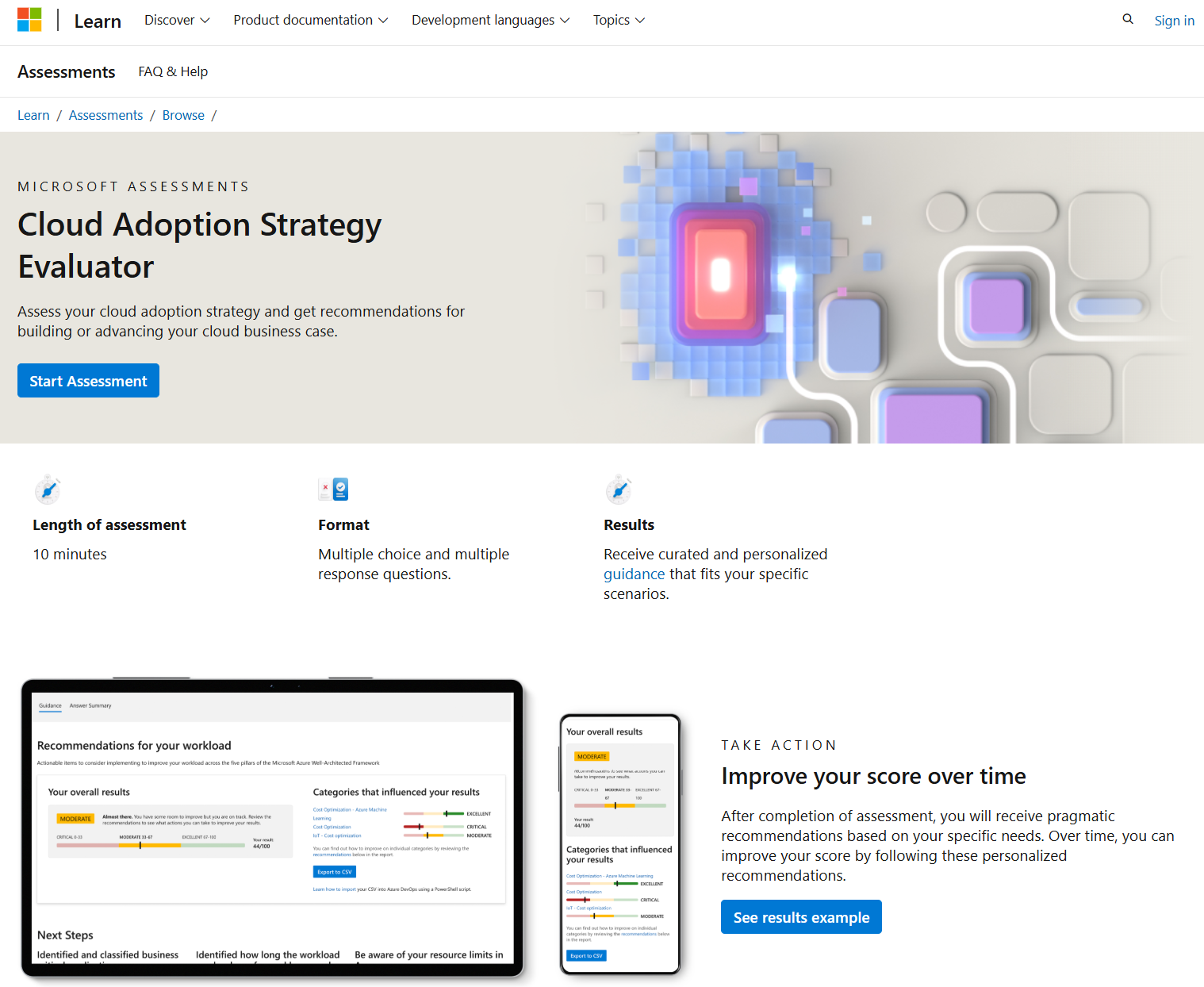Strategy
You can use the Strategy methodology to create a comprehensive plan that outlines your organization's approach when you adopt and integrate cloud technologies. A cloud adoption strategy helps you align with business goals. The Strategy methodology consists of five steps.
Assess your strategy
Assess your existing cloud adoption strategy. Use the feedback from your assessment to inform your organization of your current cloud maturity, identify gaps in your strategy, and take action to improve.
To assess your current cloud strategy posture, use the Cloud Adoption Strategy Evaluator assessment tool.

Determine your motivations, mission, and objectives
To ensure a successful cloud adoption journey, identify and understand your motivations to move to the cloud. Key motivations include cost savings, agility, scalability, and innovation. Align your cloud adoption strategies with these motivations so that you can achieve your business goals more effectively. For example, if critical business events are a top priority, you might start migration early, alongside strategy and planning efforts.
Clearly define a mission and objectives to provide direction and purpose during your cloud adoption. A mission is only valuable if you can take action on it, achieve objectives effectively, and measure the results. Create a mission statement that helps you align your objectives and key results to your organization's overall business mission.
Define clear steps that you can take to achieve your mission. These steps become your objectives. Define specific key performance indicators (KPIs) that indicate the success of your objectives.
Assign accountability for each key result, and review key results and their associated KPIs regularly. A well-defined mission and objectives help you stay focused and motivated throughout your cloud adoption journey.
Define your team
The cloud strategy team helps facilitate alignment between the business and the adoption initiatives. Assign each member of your team to a valuable function that benefits your cloud adoption. For example, you might have a lead architect to translate the business objectives into technical architectures or a compliance team to help ensure that cloud practices meet regulatory standards.
To ensure alignment in your business, your cloud strategy team should continuously seek input from other areas of your business, such as human resources or the marketing team. Form a small core strategy team, including IT, finance, and security, and involve other functions as you expand. Regularly review your team to maintain diverse representation and uncover opportunities and risks. Develop an initial strategy with your core team, and expand it as you gain executive support.
Prepare your organization
Organizational alignment helps ensure that leadership collectively supports the strategies that you plan to implement. Consider establishing alignment with a few key stakeholders early on, and expand your leadership buy-in as you iterate on your strategy implementation. You need to ensure that your leadership supports your vision and strategy.
The alignment among your business, digital, IT, and adoption strategies is also crucial for a successful cloud adoption initiative. If your organization has these strategies in place already, ensure that the adoption strategy supports the goals of these existing organizational strategies and missions. Ensure that you regularly check in with business, digital, and IT leaders to maintain your cloud initiatives' alignment with evolving goals.
To effectively take advantage of cloud benefits, you need to assess your organization's current capabilities across people, processes, technology, and partners. Understand your operating model, and identify any gaps in support, culture, roles, and skills. The cloud adoption strategy needs to factor in resources that you might need to acquire to address these gaps.
Your organization might need to transition from a project delivery model to a product delivery model to achieve broad scalability and speed. This change involves shifting from task-driven projects that have defined scopes and timelines to a continuous, outcome-driven approach that has cross-functional teams that manage development, operations, and governance end to end.
Inform your strategy
After you complete the first four steps, you can factor in the following considerations to inform your cloud adoption strategy:
Financial efficiency: Make strategic decisions to help ensure that your organization gets the best value for its investment, while minimizing unnecessary expenses.
AI: Integrate AI into your cloud platform to use advanced analytics, machine learning, and automation to optimize operations and drive business growth.
Resiliency: Design your cloud infrastructure with resiliency in mind to minimize the effect of disruptions, which helps maintain continuity and reliability for your business operations.
Security: Introduce security conversations early, adopt a Zero Trust strategy, and consider Microsoft-led workshops for a comprehensive approach to modernize your security practices.
Sustainability: Embrace sustainability to enhance your organization's operations and reputation. Evaluate your cloud strategy and incorporate green practices.